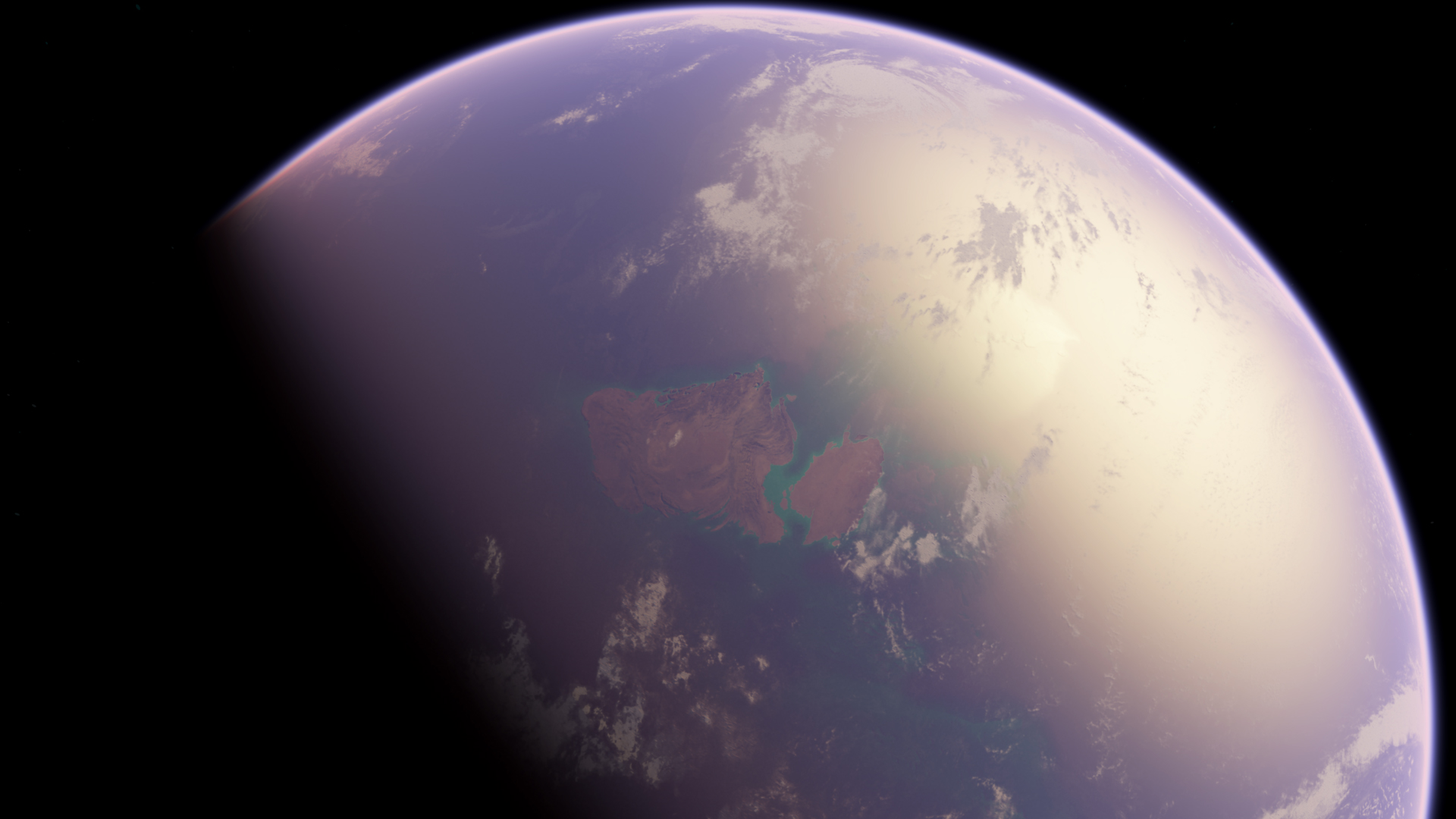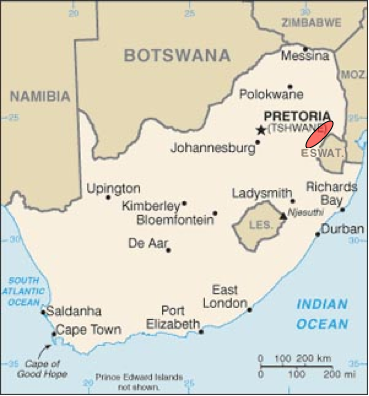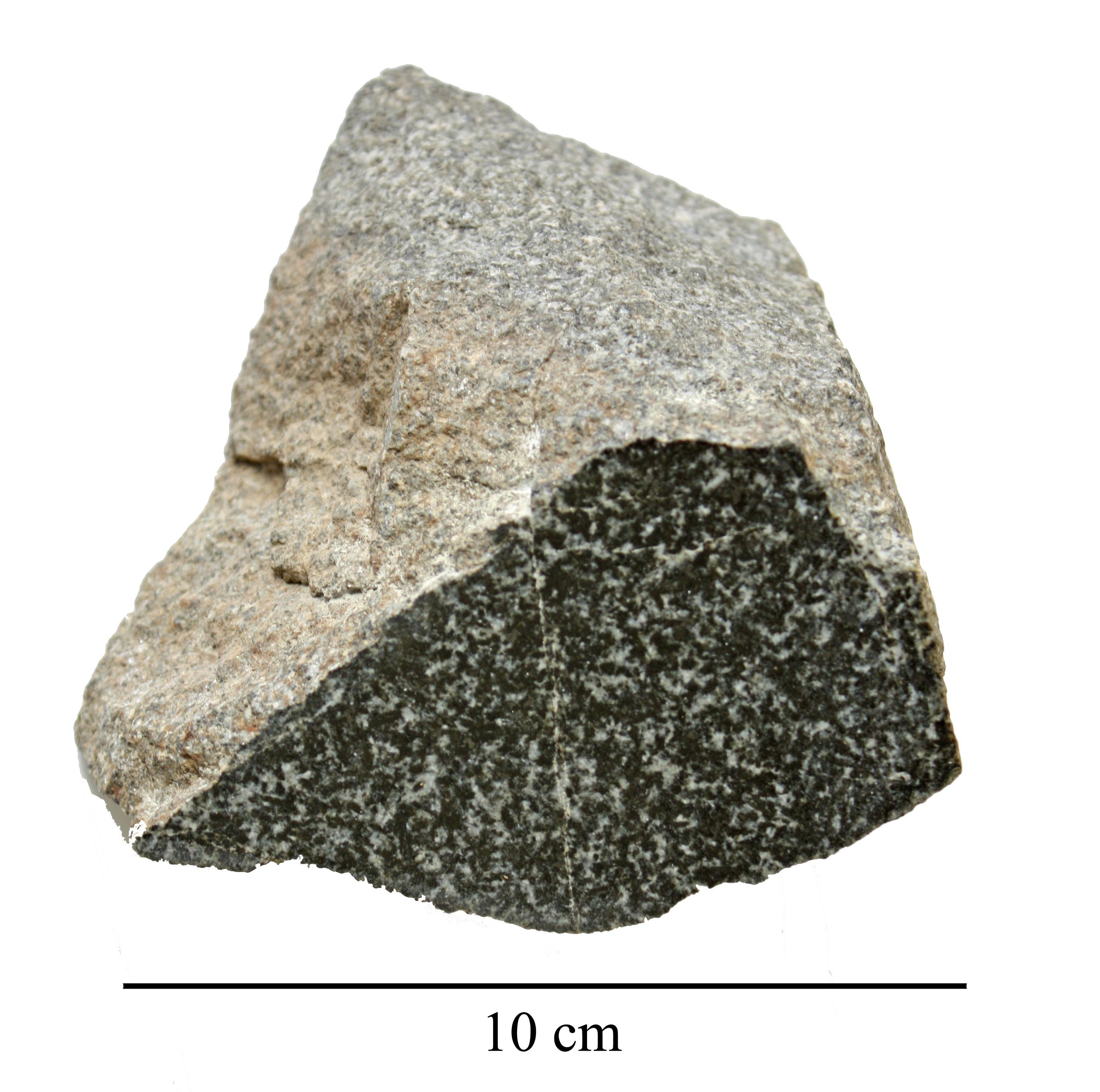|
Antarctic Creek Impact Structure
The Antarctic Creek impact structure is an impact structure in the Pilbara Craton of Western Australia. With an age of around 3.47 billion years dating to the Paleoarchean, it is the oldest known impact structure on Earth by over a billion years and the only one known from the Archean. The structure is found in the East Pilbara Terrane, one of the oldest parts of the Pilbara Craton. A geological dome called the North Pole Dome likely represents the central uplift of the structure. Evidence of the impact is shatter cones and impact spherules (formed from condensed impact vapour) found in the Antarctic Creek Member, a thick layer of sedimentary rock including "felsic to mafic volcaniclastic rocks, chert, argillite, arenite and jaspilite intruded by dolerite", located within the otherwise entirely volcanic Mount Ada Basalt, which is thick, with the Antarctic Creek Member being overlain by pillow basalts of the Mount Ada Basalt. Uranium–lead dating of detrital zircons ... [...More Info...] [...Related Items...] OR: [Wikipedia] [Google] [Baidu] |
Paleoarchean
The Paleoarchean ( ), also spelled Palaeoarchaean (formerly known as the early Archean), is a geologic era within the Archean Eon. The name derives from Greek "Palaios" ''ancient''. It spans the period of time . The era is defined chronometrically and is not referenced to a specific level of a rock section on Earth. The earliest confirmed evidence of life comes from this era, and Vaalbara, one of Earth's earliest supercontinents, may have formed during this era. Early life The geological record from the Paleoarchean era is very limited. Due to deformation and metamorphism, most rocks from the Paleoarchean era cannot provide any useful information. There are only two locations in the world containing rock formations that are intact enough to preserve evidence of early life: the Kaapvaal craton in Southern Africa and the Pilbara Craton in Western Australia. The Dresser Formation is located in the Pilbara Craton, and contains sedimentary rock from the Paleoarchean Era. It ... [...More Info...] [...Related Items...] OR: [Wikipedia] [Google] [Baidu] |
Arenite
Arenite (from the Latin ''arena'', "sand") is a sedimentary clastic rock with sand grain size between 0.0625 mm (0.00245 in) and 2 mm (0.08 in) and containing less than 15% matrix. The related adjective is ''arenaceous''. The equivalent Greek-derived term is psammite, though this is more commonly used for metamorphosed sediments. Since it refers to grain size rather than chemical composition, the term is used for example in the classification of clastic carbonatic limestones, as the granulometrically equivalent term sandstone is not appropriate for limestone. Other arenites include sandstones, arkoses, greensands, and greywackes. Arenites mainly form by erosion of other rocks or turbiditic re-deposition of sands. Some arenites contain a varying amount of carbonatic components and thus belong to the rock-category of carbonatic sandstones or silicatic limestones. Arenites often appear as massive or bedded medium-grained rocks with a middling- to wide-space ... [...More Info...] [...Related Items...] OR: [Wikipedia] [Google] [Baidu] |
Impact Crater
An impact crater is a depression (geology), depression in the surface of a solid astronomical body formed by the hypervelocity impact event, impact of a smaller object. In contrast to volcanic craters, which result from explosion or internal collapse, impact craters typically have raised rims and floors that are lower in elevation than the surrounding terrain. Impact craters are typically circular, though they can be elliptical in shape or even irregular due to events such as landslides. Impact craters range in size from microscopic craters seen on lunar rocks returned by the Apollo Program to simple bowl-shaped depressions and vast, complex, multi-ringed impact basins. Meteor Crater is a well-known example of a small impact crater on Earth. Impact craters are the dominant geographic features on many solid Solar System objects including the Moon, Mercury (planet), Mercury, Callisto (moon), Callisto, Ganymede (moon), Ganymede, and most small moons and asteroids. On other planet ... [...More Info...] [...Related Items...] OR: [Wikipedia] [Google] [Baidu] |
List Of Impact Craters On Earth
This list of impact structures (including impact craters) on Earth contains the majority of the 194+ confirmed impact structures given in the Earth Impact Database as of 2024. Alphabetical lists for different continents can be found under Impact structures by continent below. Unconfirmed structures can be found at List of possible impact structures on Earth. Confirmed impact structures listed by size and age These features were caused by the collision of meteors (consisting of large fragments of asteroids) or comets (consisting of ice, dust particles and rocky fragments) with the Earth. For eroded or buried craters, the stated diameter typically refers to the best available estimate of the original rim diameter, and may not correspond to present surface features. Time units are either in ka (thousands) or Ma (millions) of years. 10 ka or less Less than ten thousand years old, and with a diameter of or more. The EID lists fewer than ten such craters, and the largest in t ... [...More Info...] [...Related Items...] OR: [Wikipedia] [Google] [Baidu] |
Dresser Formation
The Dresser Formation is a Paleoarchean geologic formation that outcrops as a generally circular ring of hills in the North Pole Dome area of the East Pilbara Terrane of the Pilbara Craton of Western Australia. This formation is one of many formations that comprise the Warrawoona Group, which is the lowermost of four groups that comprise the Pilbara Supergroup. The Dresser Formation is part of the Panorama greenstone belt that surrounds and outcrops around the intrusive North Pole Monzogranite. Dresser Formation consists of metamorphosed, blue, black, and white bedded chert; pillow basalt; carbonate rocks; minor felsic volcaniclastic sandstone and conglomerate; hydrothermal barite; evaporites; and stromatolites. The lowermost of three stratigraphic units that comprise the Dresser Formation contains some of the Earth's earliest commonly accepted evidence of life such as morphologically diverse stromatolites, microbially induced sedimentary structures, putative organic microfossi ... [...More Info...] [...Related Items...] OR: [Wikipedia] [Google] [Baidu] |
Barberton Greenstone Belt
The Barberton Greenstone Belt is a geologic formation situated on the eastern edge of the Kaapvaal craton in South Africa. It is known for its gold mineralisation and for its komatiites, an unusual type of ultramafic volcanic rock named after the Komati River that flows through the belt. Some of the oldest exposed rocks on Earth (greater than 3.6 Ga) are located in the Barberton Greenstone Belt of the Eswatini–Barberton areas and these contain some of the oldest traces of life on Earth, second only to the Isua Greenstone Belt of Western Greenland. The Makhonjwa Mountains make up 40% of the Baberton belt. It is named after the town Barberton, Mpumalanga. History and description The Barberton Greenstone Belt consists of a sequence of mafic to ultramafic lavas and metasedimentary rocks emplaced and deposited between 3.5 and 3.2 Ga. The granitoid rocks were emplaced over a 500-million-year time span and can be divided into two suites: The tonalite-trondhjemite-granodiorite (TT ... [...More Info...] [...Related Items...] OR: [Wikipedia] [Google] [Baidu] |
Detrital Zircon Geochronology
Detrital zircon geochronology is the science of geochronology, analyzing the age of zircons deposited within a specific sedimentary rock, sedimentary unit by examining their inherent radioisotopes, most commonly the uranium–lead dating, uranium–lead ratio. Zircon is a common Accessory mineral, accessory or trace mineral constituent of most granite and felsic igneous rocks. Due to its hardness, durability and chemical inertness, zircon persists in sedimentary deposits and is a common constituent of most sands. Zircons contain trace amounts of uranium and thorium and can be dated using several modern analytical techniques. Detrital zircon geochronology has become increasingly popular in geological studies from the 2000s mainly due to the advancement in radiometric dating techniques. Detrital zircon age data can be used to constrain the maximum depositional age, determine provenance (geology), provenance, and reconstruct the tectonic setting on a regional scale. Detrital zirco ... [...More Info...] [...Related Items...] OR: [Wikipedia] [Google] [Baidu] |
Uranium–lead Dating
Uranium–lead dating, abbreviated U–Pb dating, is one of the oldest and most refined of the radiometric dating schemes. It can be used to date rocks that formed and crystallised from about 1 million years to over 4.5 billion years ago with routine precisions in the 0.1–1 percent range. The method is usually applied to zircon. This mineral incorporates uranium and thorium atoms into its crystal structure, but strongly rejects lead when forming. As a result, newly-formed zircon crystals will contain no lead, meaning that any lead found in the mineral is radiogenic. Since the exact rate at which uranium decays into lead is known, the current ratio of lead to uranium in a sample of the mineral can be used to reliably determine its age. The method relies on two separate decay chains, the uranium series from 238U to 206Pb, with a half-life of 4.47 billion years and the actinium series from 235U to 207Pb, with a half-life of 710 million years. Decay routes Uranium decays to l ... [...More Info...] [...Related Items...] OR: [Wikipedia] [Google] [Baidu] |
Pillow Basalt
Basalt (; ) is an aphanitic (fine-grained) extrusive igneous rock formed from the rapid cooling of low-viscosity lava rich in magnesium and iron ( mafic lava) exposed at or very near the surface of a rocky planet or moon. More than 90% of all volcanic rock on Earth is basalt. Rapid-cooling, fine-grained basalt is chemically equivalent to slow-cooling, coarse-grained gabbro. The eruption of basalt lava is observed by geologists at about 20 volcanoes per year. Basalt is also an important rock type on other planetary bodies in the Solar System. For example, the bulk of the plains of Venus, which cover ~80% of the surface, are basaltic; the lunar maria are plains of flood-basaltic lava flows; and basalt is a common rock on the surface of Mars. Molten basalt lava has a low viscosity due to its relatively low silica content (between 45% and 52%), resulting in rapidly moving lava flows that can spread over great areas before cooling and solidifying. Flood basalts are thick sequ ... [...More Info...] [...Related Items...] OR: [Wikipedia] [Google] [Baidu] |
Dolerite
Diabase (), also called dolerite () or microgabbro, is a mafic, holocrystalline, subvolcanic rock equivalent to volcanic basalt or plutonic gabbro. Diabase dikes and sills are typically shallow intrusive bodies and often exhibit fine-grained to aphanitic chilled margins which may contain tachylite (dark mafic glass). ''Diabase'' is the preferred name in North America, while ''dolerite'' is the preferred name in the rest of the English-speaking world, where sometimes the name ''diabase'' refers to altered dolerites and basalts. Some geologists prefer to avoid confusion by using the name ''microgabbro''. The name ''diabase'' comes from the French , and ultimately from the Greek 'act of crossing over, transition', whereas the name ''dolerite'' comes from the French , from the Greek 'deceitful, deceptive', because it was easily confused with diorite. Petrography Diabase normally has a fine but visible texture of euhedral lath-shaped plagioclase crystals (62%) set in a ... [...More Info...] [...Related Items...] OR: [Wikipedia] [Google] [Baidu] |
Intruded
Intrusive rock is formed when magma penetrates existing rock, crystallizes, and solidifies underground to form ''intrusions'', such as batholiths, dikes, sills, laccoliths, and volcanic necks.Intrusive RocksIntrusive rocks accessdate: March 27, 2017.Igneous intrusive rocks, accessdate: March 27, 2017.Britannica.comintrusive rock , geology , Britannica.com accessdate: March 27, 2017. Intrusion is one of the two ways igneous rock can form. The other is extrusion, such as a volcanic eruption or similar event. An intrusion is any body of intrusive igneous rock, formed from magma that cools and solidifies within the crust of the planet. In contrast, an ''extrusion'' consists of extrusive rock, formed above the surface of the crust. Some geologists use the term plutonic rock synonymously with intrusive rock, but other geologists subdivide intrusive rock, by crystal size, into coarse-grained plutonic rock (typically formed deeper in the Earth's crust in batholiths or stocks) and me ... [...More Info...] [...Related Items...] OR: [Wikipedia] [Google] [Baidu] |
Jaspillite
Jaspillite (or jaspilite), also called itabirite or jasper taconite, is a chemical rock formed similar to chert, but is generally quite iron-rich. Jaspillite is typically a banded mixture of hematite and quartz common in the banded iron formation rocks of Proterozoic and Archaean age in the Canadian Shield. Jaspillite is also formed as exhalative chemical sediments in certain lead-zinc ore deposits, and as a hydrothermal alteration facies In geology, a facies ( , ; same pronunciation and spelling in the plural) is a body of rock with distinctive characteristics. The characteristics can be any observable attribute of rocks (such as their overall appearance, composition, or con ... around submarine volcanism. It is used as a gemstone. References Jaspillite and Taconite etymology [...More Info...] [...Related Items...] OR: [Wikipedia] [Google] [Baidu] |







